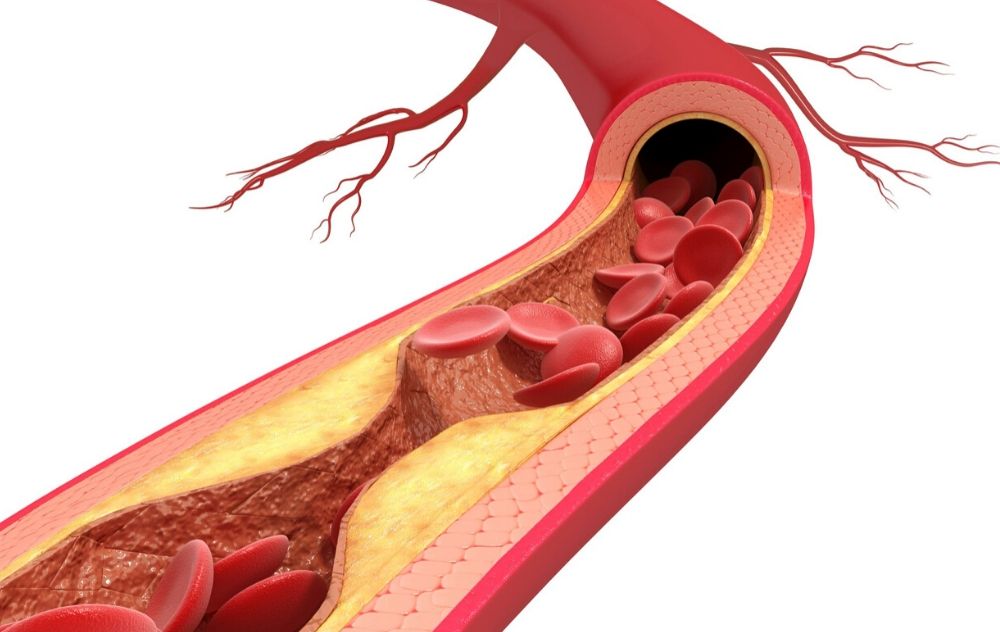Atherosclerosis is a common yet serious condition where plaque or fatty deposits made up largely of cholesterol, cellular waste products, calcium, and fatty substances build up in your arteries. It’s a major cause of Peripheral Artery Disease (PAD), heart attack, and stroke in Americans every year. Besides PAD, atherosclerosis can also cause below diseases:
- Angina or chest pain due to reduced blood flow to the heart muscles
- Carotid artery disease in which case there is plaque buildup in the arteries supplying blood to the brain, and
- Chronic kidney disease
Atherosclerosis is a slow process and may start in childhood for some people. The process of plaque buildup can accelerate due to a variety of reasons, such as…
- High cholesterol
- High blood sugar level
- Being overweight, and
- High blood pressure
Though some hardening of arteries is normal as we age, it may become problematic in many people in their 40s and above, especially those with high-risk factors such as:
- Elevated levels of cholesterol and triglycerides in the blood
- High blood pressure
- High blood sugar level
- Being a smoker
- Family history of atherosclerosis
- Being obese or overweight
- Being an older male
- Lack of exercise and leading an inactive lifestyle
Cigarette Smoking
Cigarette smoking is one of the major causes of atherosclerosis as it promotes the formation of fatty deposits and accelerates the buildup of plaque.
Risk of High Blood Pressure
Atherosclerosis can put you at an increased risk of high blood pressure as the arteries are hardened, interfering with blood flow. Atherosclerosis reduces the amount of oxygen and other nutrients from reaching your organs and cells. Moreover, the heart has to pump harder to push the blood through the clot, causing an increase in blood pressure.
Key Symptoms of Atherosclerosis
- Chest pain or angina
- Fatigue
- Shortness of breath
- Pain in the leg, chest, arm or anywhere else where there is a blockage
- Confusion and lack of concentration due to reduced supply to the brain
- Muscle weakness due to lack of circulation
Plaque Presents a Double Threat
Plaque presents a double threat to an affected individual. It increases the possibility of forming a blood clot or thrombus. Moreover, if it breaks off, it will be carried by the bloodstream until it gets stuck somewhere in the narrowed enough region of an artery. If it sticks in the arteries leading to your heart, risk for heart attack is high. This is because the clogged arteries causes the heart to struggle to get enough oxygenated blood. You can also have a stroke if the plaque sticks in a narrow artery leading to your brain as your brain will not be able to get its adequate supply of blood.
PAD Due to Plaque
When plaque builds up inside your leg artery, you may develop PAD. PAD is another common condition that completely blocks some of the veins in the legs. Untreated PAD can result in gangrene or tissue death as the leg tissue won’t get enough oxygen or nutrients. The PAD complication can sometimes require surgery to prevent further infection and damage to healthy tissue.
Atherosclerosis can be diagnosed during a physical exam. Whether you are seeing your primary care physician or a vascular specialist, they will likely check for a weakened pulse, abnormal widening of the artery, and slow wound healing that could be indicative of the disease.
PAD due to atherosclerosis can be treated with many existing options for successful outcomes, including surgical and non-surgical.
Non-Surgical PAD Treatment at USA Vascular Centers
At USA Vascular Centers, we offer non-surgical PAD treatment through balloon angioplasty with stenting.
In this non-surgical PAD procedure, our interventional radiologist will insert a catheter or a thin tube with a camera through your groin. The movement of the catheter is seen on a big monitor by the doctor. A dye will be injected through the catheter which allows the vascular specialist to locate the blockage and measure its severity.
Online Doctor Visits
At USA Vascular Centers we are now offering the opportunity to consult with a vascular specialist from the comfort of your home. You no longer need to leave your home when you request a telemedicine appointment.
We ensure you that when you schedule an online doctor visit you can an expect the same high quality patient standards as an in-office visit. For your telemedicine virtual consultation you can use your smartphone, tablet, laptop or desktop with a camera and internet access.
Call us at 888-773-2193 to schedule your virtual doctor visit with our expert vascular doctors, or you can schedule an appointment online.

